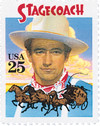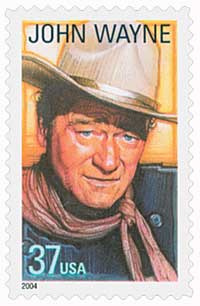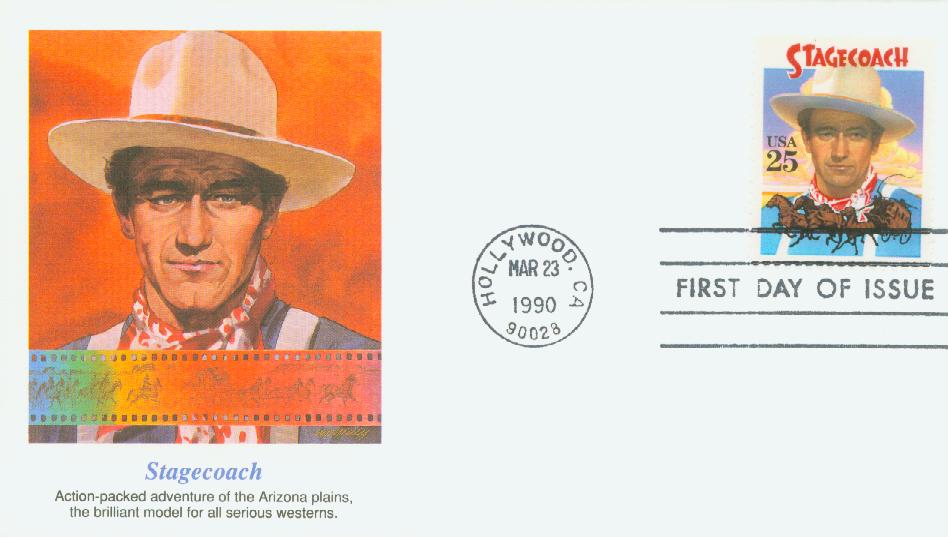
# 2448 - 1990 25c Classic Films: Stagecoach
US #2448
1990 Stagecoach
- Part of a Set of 4 Classic Films stamp
- Commemorates 50th anniversary of the Oscar-nominated film
- Celebrates the Golden Age of Hollywood
Stamp Category: Commemorative
Set: Classic Films
Value: 25¢, First-Class mail rate
First Day of Issue: March 23 1990
First Day City: Hollywood, California
Quantity Issued: 44,202,000
Printed by: American Bank Note Company
Printing Method: Photogravure
Format: Panes of 40, from printing cylinders of 160
Perforations: 11
Why the stamp was issued: This stamp is part of a block of four honoring classic films from Hollywood’s golden era. Each of the four films featured received Academy Award nominations in 1940.
About the stamp design: Each stamp resembles a miniature movie poster with bright, glossy colors. They picture the stars of each film, as well as the title and a scene from the movie in the background. Thomas Blackshear was chosen to do the artwork for the stamps. He used original movie posters and photographs from the films as inspiration.
First Day City: The First Day of Issue ceremony for the Classic Movie stamps took place at the Academy of Motion Pictures Arts and Sciences in Beverly Hills, California, though the postmark was Hollywood. This was the location of the 62nd Academy Awards celebration three days later.
Unusual fact about these stamps: The stamps were originally planned for issue in 1989, the 50th anniversary of release of these films. Difficulties with obtaining permission from the film company and families of the stars pictured delayed the stamps until 1990. This coincided with the Academy Awards ceremony for these films.
About the Set: Time magazine called 1939 the “year of genius and glitter” that was “the most memorable 12 months in the history of the American cinema.” All the films featured in this set were produced that year, and all were nominated for Academy Awards (or Oscars). The four movies chosen for the stamps were: The Wizard of Oz, Gone with the Wind, Beau Geste, and Stagecoach.
History the stamp represents:
Stagecoach has been called director John Ford’s “greatest epic of frontier.” Filmed on location in Arizona, the film was an adaptation of the short story “The Stage of Lordsburg.” Stagecoach was the first major role for actor John Wayne. The film received seven Academy Awards nomination and won two.
Birth Of John Wayne
He was named Marion Morrison after his grandfather. The Morrisons later moved to a homestead in Glendale, California, where Wayne’s father opened a pharmacy in the same building as a movie theater. Wayne was allowed to go to the movies for free several times a week. It was also in California that Wayne’s father taught him to ride horses, handle firearms, and to stand tall as a man.
Wayne received the nickname “Little Duke” from a fireman he saw every morning as he walked with his large Airedale Terrier dog, Duke. The name stayed with him for the rest of his life.
In high school, Wayne was both an honor student and an excellent athlete. He received a football scholarship to the University of Southern California, and while there, worked as a scenery mover for Fox Studios. After suffering a bodysurfing injury and losing his scholarship, Wayne was soon cast in bit parts in movies.
Wayne earned his first spot in a movie replacing a stunt man who refused to go in the water off Catalina Island because it was too rough. The director on the film was John Ford, who later launched Wayne’s career by starring him in the movie Stagecoach. However, Wayne would make more than 80 grade-B films before then.
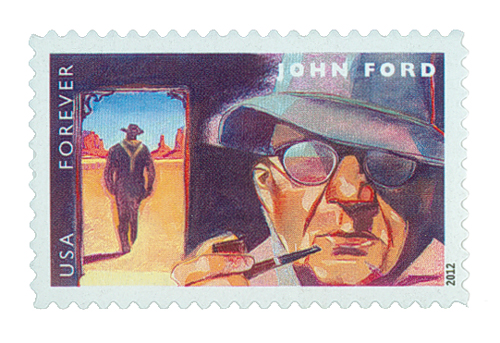
Wayne’s first starring role came in the 1930 film The Big Trail, Hollywood’s first epic Western sound motion picture. It was at this point that he adopted his stage name. The film’s director first suggested Anthony Wayne, after Revolutionary War General “Mad” Anthony Wayne, but Fox executives didn’t like it. They eventually settled on “John Wayne,” though Wayne himself wasn’t even present for the discussion or decision.
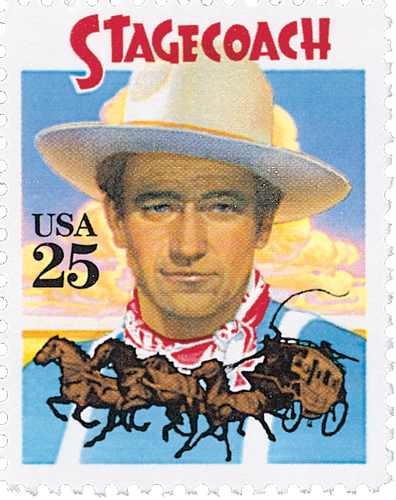
Wayne continued to make predominantly westerns, but it wasn’t until Stagecoach in 1939, that he attained national stardom. This movie was director John Ford’s most-acclaimed film. It was nominated for seven Academy Awards and won two. It introduced America to a rising young star named John Wayne.
Wayne’s first color film was Shepherd of the Hills, in 1941. One of his most popular roles was as a heroic pilot in The High and the Mighty, in 1954. Critics and fans alike praise his portrayal of Ethan Edwards in The Searchers (1956) as one of his best and most complex performances.
Wayne became an American icon and his name and image became synonymous with the rugged Wild West. Wayne’s film performances made him a symbol of the American cowboy, the courageous, patriotic soldier, and the fearless lawman in search of justice. His performance in True Grit in 1969 earned him the Oscar for Best Actor. In 1980, President Jimmy Carter awarded him America’s highest civilian honor, the Presidential Medal of Freedom.
Wayne played the male lead role in 142 of 153 films, setting an industry record. As Hollywood’s most outspoken conservative Republican, Wayne was asked to run for president in 1968. He declined because he didn’t believe an actor could be elected to the nation’s highest office.

John Wayne starred in over 200 movies during a span of 50 years. Sadly, it was the filming of a 1955 movie, The Conqueror that many think killed the “Duke.” The filming took place near a nuclear test site where the radioactive bombs had recently been dropped. Although most knew about the radiation (there’s even a picture of Wayne with a Geiger counter) they obviously didn’t realize the danger they were in.
US #2448
1990 Stagecoach
- Part of a Set of 4 Classic Films stamp
- Commemorates 50th anniversary of the Oscar-nominated film
- Celebrates the Golden Age of Hollywood
Stamp Category: Commemorative
Set: Classic Films
Value: 25¢, First-Class mail rate
First Day of Issue: March 23 1990
First Day City: Hollywood, California
Quantity Issued: 44,202,000
Printed by: American Bank Note Company
Printing Method: Photogravure
Format: Panes of 40, from printing cylinders of 160
Perforations: 11
Why the stamp was issued: This stamp is part of a block of four honoring classic films from Hollywood’s golden era. Each of the four films featured received Academy Award nominations in 1940.
About the stamp design: Each stamp resembles a miniature movie poster with bright, glossy colors. They picture the stars of each film, as well as the title and a scene from the movie in the background. Thomas Blackshear was chosen to do the artwork for the stamps. He used original movie posters and photographs from the films as inspiration.
First Day City: The First Day of Issue ceremony for the Classic Movie stamps took place at the Academy of Motion Pictures Arts and Sciences in Beverly Hills, California, though the postmark was Hollywood. This was the location of the 62nd Academy Awards celebration three days later.
Unusual fact about these stamps: The stamps were originally planned for issue in 1989, the 50th anniversary of release of these films. Difficulties with obtaining permission from the film company and families of the stars pictured delayed the stamps until 1990. This coincided with the Academy Awards ceremony for these films.
About the Set: Time magazine called 1939 the “year of genius and glitter” that was “the most memorable 12 months in the history of the American cinema.” All the films featured in this set were produced that year, and all were nominated for Academy Awards (or Oscars). The four movies chosen for the stamps were: The Wizard of Oz, Gone with the Wind, Beau Geste, and Stagecoach.
History the stamp represents:
Stagecoach has been called director John Ford’s “greatest epic of frontier.” Filmed on location in Arizona, the film was an adaptation of the short story “The Stage of Lordsburg.” Stagecoach was the first major role for actor John Wayne. The film received seven Academy Awards nomination and won two.
Birth Of John Wayne
He was named Marion Morrison after his grandfather. The Morrisons later moved to a homestead in Glendale, California, where Wayne’s father opened a pharmacy in the same building as a movie theater. Wayne was allowed to go to the movies for free several times a week. It was also in California that Wayne’s father taught him to ride horses, handle firearms, and to stand tall as a man.
Wayne received the nickname “Little Duke” from a fireman he saw every morning as he walked with his large Airedale Terrier dog, Duke. The name stayed with him for the rest of his life.
In high school, Wayne was both an honor student and an excellent athlete. He received a football scholarship to the University of Southern California, and while there, worked as a scenery mover for Fox Studios. After suffering a bodysurfing injury and losing his scholarship, Wayne was soon cast in bit parts in movies.
Wayne earned his first spot in a movie replacing a stunt man who refused to go in the water off Catalina Island because it was too rough. The director on the film was John Ford, who later launched Wayne’s career by starring him in the movie Stagecoach. However, Wayne would make more than 80 grade-B films before then.

Wayne’s first starring role came in the 1930 film The Big Trail, Hollywood’s first epic Western sound motion picture. It was at this point that he adopted his stage name. The film’s director first suggested Anthony Wayne, after Revolutionary War General “Mad” Anthony Wayne, but Fox executives didn’t like it. They eventually settled on “John Wayne,” though Wayne himself wasn’t even present for the discussion or decision.

Wayne continued to make predominantly westerns, but it wasn’t until Stagecoach in 1939, that he attained national stardom. This movie was director John Ford’s most-acclaimed film. It was nominated for seven Academy Awards and won two. It introduced America to a rising young star named John Wayne.
Wayne’s first color film was Shepherd of the Hills, in 1941. One of his most popular roles was as a heroic pilot in The High and the Mighty, in 1954. Critics and fans alike praise his portrayal of Ethan Edwards in The Searchers (1956) as one of his best and most complex performances.
Wayne became an American icon and his name and image became synonymous with the rugged Wild West. Wayne’s film performances made him a symbol of the American cowboy, the courageous, patriotic soldier, and the fearless lawman in search of justice. His performance in True Grit in 1969 earned him the Oscar for Best Actor. In 1980, President Jimmy Carter awarded him America’s highest civilian honor, the Presidential Medal of Freedom.
Wayne played the male lead role in 142 of 153 films, setting an industry record. As Hollywood’s most outspoken conservative Republican, Wayne was asked to run for president in 1968. He declined because he didn’t believe an actor could be elected to the nation’s highest office.

John Wayne starred in over 200 movies during a span of 50 years. Sadly, it was the filming of a 1955 movie, The Conqueror that many think killed the “Duke.” The filming took place near a nuclear test site where the radioactive bombs had recently been dropped. Although most knew about the radiation (there’s even a picture of Wayne with a Geiger counter) they obviously didn’t realize the danger they were in.




